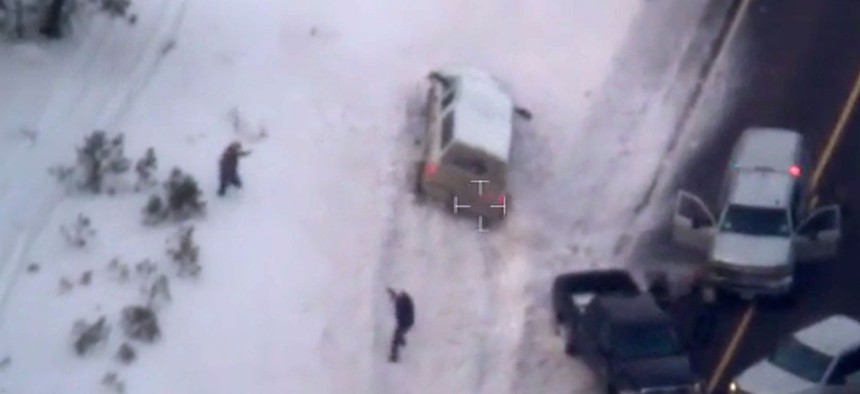FBI Video of Shooting of Oregon Occupier LaVoy Finicum
The bureau released footage that shows the slain militiaman trying to barrel past a roadblock, then allegedly reaching for a gun in his pocket.
What went wrong when Oregon State Police and the FBI tried to arrest leaders of the illegal occupation at Malheur National Wildlife Refuge ?
During the traffic stop on Tuesday, police managed to arrest six militia members, including leader Ammon Bundy, without much trouble. But the incident ended with an eighth, LaVoy Finicum, shot and killed. Initially, details were sparse, and police wouldn’t even confirm that Finicum was the man they had shot. But late Thursday they released video, shot from a plane, of the incident that clarifies some of what happened. This is an edited version, but the full, nearly 27-minute video, is here .
The seven people were driving from the refuge to the town of John Day, along Highway 395, in two SUVs when police attempted to stop them. A Jeep carried Ammon Bundy and Brian Cavalier, both of whom face federal charges, and a driver who does not. (A man named Mark McConnell has said he was the driver .) They all exited the car without incident. But a white truck, driven by Finicum, kept going, then stopped further down the road. Police approached and gave commands to the passengers. Ryan Payne left the truck. Then the driver took off at high speed, headed down the deserted road.
But there was a roadblock ahead. As Finicum neared the roadblock, made up of three trucks, he veered left, trying to get around them, but his truck lodged in a snowdrift. (The film shows Finicum nearly hitting an FBI agent.) Once again, police shouted commands to them. Finicum, 55, exited the car almost immediately, with his hands up, and started walking away from the officers. Then he reached for his pocket, at which point a Oregon trooper, from the trees away from the road, shot him. “On at least two occasions, Finicum reaches his right hand toward a pocket on the left inside portion of his jacket. He did have a loaded 9-millimeter semiautomatic handgun in that pocket,” said Greg Bretzing , the FBI agent in charge of Oregon. Bretzing praised officers for not shooting earlier, when Finicum tried to barrel through.
Over what one imagines were a tense few minutes, police sheltered behind their trucks, apparently concerned that other riders might shoot. They fired flash-bangs to disorient the passengers and also OC capsules, which Bretzing described as similar to pepper spray.
As Finicum lay in the snow, the rest of the truck’s occupants slowly exited the truck without incident. The police wade through heavy snow to get to Finicum and start providing aid, about 10 minutes after he was shot. Bretzing did not say how many times Finicum was shot but said it was “ in the single digits .” He said officers also found three loaded guns in the truck, including two .223 caliber semi-automatic rifles and a .38 special revolver. Only police fired shots. It has been reported that Ryan Bundy suffered a minor wound in the encounter, but it’s not clear how that happened.
If the video provides some sense of how the shooting went down, it still doesn’t offer much indication of why. Did Finicum think he could make it through the snow? Was it his decision alone to drive ahead, or did the other passengers agree? Why was he reaching for his pocket? Did he expect police would fire? (He’d previously said he would rather die than be arrested.) Why did all the other passengers in both cars surrender without incident? These questions seem likely to remain unanswered at least until the others describe the moment.
The shooting and arrests seem to have effectively sapped the occupation of its energy. Ammon Bundy, in a statement made through his lawyer, called on the remnant to leave, and police surrounded the refuge and threw up road blocks. Several militia members have been arrested as they leave. There are now just four people left, and they are demanding that police agree not to arrest them in exchange for leaving.
“We're asking, just drop the charges and we're willing to go. But if they're not willing to do that, we're all just willing to stay here and see what happens,” one man, tentatively identified as David Fry, says in a video from the refuge posted Thursday. Fry told the Los Angeles Times ’ Matt Pearce that three of them have been told they’re free to go, but a fourth faces a criminal charge. They also don’t want authorities to check their guns. If it’s hard to imagine police agreeing to such an exchange, it’s also true that the occupation’s demands—including release of two men imprisoned for federal crimes and federal surrender of the refuge—also always seemed wildly unrealistic.
Those arrested so far have been charged with conspiracy to impede officers of the United States from discharging their official duties through the use of force, intimidation, or threats, a federal felony carrying up to six years in prison. As the L.A. Times explained , prosecutors are pursuing a conspiracy charge in part because the burden of proof is lower: They don’t need to prove that crimes occurred, necessarily, but that the militia intended to commit them. And the FBI was unwittingly helped by the occupiers’ own broadcasts, which conveyed some of their planning and coordination.
In an ironic historical twist, The Oregonian notes that the law with the conspiracy charge was originally passed to prosecute Confederate secessionists who took over federal property during the Civil War. It doesn’t appear that anyone was indicted under the law during the war, and it’s seldom used today. It turns out, however, that it’s as illegal to take up arms, seize federal property, and demanding the government relinquish it in 2016 as it was in 1861.
NEXT STORY: How to Master Situational Leadership







